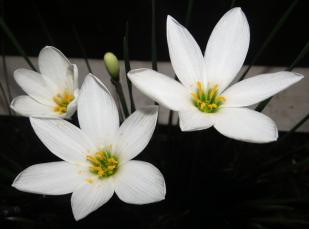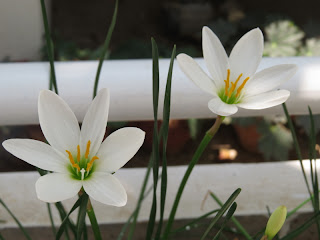UNSEASONAL RAINS BRINGS A PLEASANT SURPRISE

|
It was a Wednesday and I decided to bunk office to spend some time with a cousin of mine who had come home for a week, just having finished her board examination. The plan was to take her to the Bannerghatta National Park after having failed to make it there on time on the previous weekend, all thanks to traffic congestion caused by an annual religious procession near Gottigere. However, the program got cancelled as the guest, probably scared of Bengaluru's infamous traffic jams, thought it was wise to stay home and my tryst with city's protected area was put off for some more time, yet again. The temperature which had soared to mid 30s in March end had dipped somewhat as rains lashed different parts of the city, bringing much needed relief and averting the imminent water crisis, atleast for the time being. Besides, making the weather pleasant, the unseasonal showers also brought a few surprises with them as three small flowers, virgin white in colour, bloomed in our garden providing a delight to the eyes. As the cousin was busy chatting with my mother, I took out my new camera - Canon SX50HS, a gift from Da and Bhabhi for my birthday and clicked some snaps, few of which are posted below.
I had been familiar with these florets ever since we shifted to Bengaluru in July 2011 and instantly took a liking for them. They seem to be quite common here and are grown in gardens, both outside homes and corporate offices. A couple of months later, my mom brought home few bulbs from a lady in the neighbourhood, which in no time, had propagated to cover the entire planting area in the boundary wall below the almond tree. With the tree protecting it from the sun and rains providing ample water, the plant bloomed in full splendour. The blossom which consisted of about six to eight little flowers at the peak of the rains is indeed a sight to behold, especially against the backdrop of dark green leaves. Those captured in the images below are the first flowers of this season. After clicking several photos of these flowers from different angles, zooming in and out to get the details and right background, I realized that all this while I had never known the name of the species. I started googling with searches like 'White Flower', 'White Flower India', 'White Flower Bangalore' and so on but could not find anything relevant. Next, I tried out the image search but it returned everything except what I was looking for. Looks like Larry Page needs to invest more time improving the Image Processing algorithm that Google uses. It was not until the next morning when I came across Rohini Kamath's blog - Bees and Birds (Link), that I realized that these flowers are known as Rain Lilies.

.JPG)
| .JPG)
|
Belonging to the family Amaryllidacae (Amaryllis) and scientifically known as Zephyranthes, these monocotyledons are named after Zephyr - the Greek God of the western winds which signal the onset of spring in the lands that they are native to - the Americas; coinciding with the time of the year when they blossom. In several other countries like India, they flower during rains and hence are commonly referred to as the Rain Lily. It is a sturdy plant with ability to withstand cold weather or go without water for a prolonged period of time. The leaves, coloured in different shades of dark green are long, slender and shaped in the form of grass blades. Differentiation between sub species is mainly done on characteristics of bulb, leaves and most importantly - the floral morphology. While there are several kinds of Zephyrs occurring in nature as well as through cross with relatives within the Amaryllis or other related families, the most well known ones are the Rose Pink Rain Lily (Z. Rosea - Link), the Pink Rain Lily (Z. Carinata), the Yellow Rain Lily (Z. Citrina) and lastly, the most popular of them all - the White Rain Lily (Z. Candida).
As you might have already guessed, the ones that I have captured here are the White Rain Lilies. The bloom are funnel shaped and appear on the top of the shoot which are lighter in colour as compared to the rest of the foliage. The buds are elongated, being circular at the tip. They open in three to four days. The flowers which face the sun survive for another four days on an average. They have six petals and on observing from a close range, one can clearly see thin black lines on them. There are six stamens and a single stigma that form a circular pattern at the centre which has a tinge of light green. The style which holds the stigma on its top is milky white in colour and the stamens hold the yellow pollen grains. There is no distinct fragrance. Nonetheless, I did see several kinds of insects visiting them, thereby helping in pollination, probably attracted by the sight more than the scent.
As you might have already guessed, the ones that I have captured here are the White Rain Lilies. The bloom are funnel shaped and appear on the top of the shoot which are lighter in colour as compared to the rest of the foliage. The buds are elongated, being circular at the tip. They open in three to four days. The flowers which face the sun survive for another four days on an average. They have six petals and on observing from a close range, one can clearly see thin black lines on them. There are six stamens and a single stigma that form a circular pattern at the centre which has a tinge of light green. The style which holds the stigma on its top is milky white in colour and the stamens hold the yellow pollen grains. There is no distinct fragrance. Nonetheless, I did see several kinds of insects visiting them, thereby helping in pollination, probably attracted by the sight more than the scent.



|
.JPG)
|
For more on Rain Lilies:
(1) The Rose Rain Lily (Link)

No comments:
Post a Comment
Leave your comments/suggestions/views here